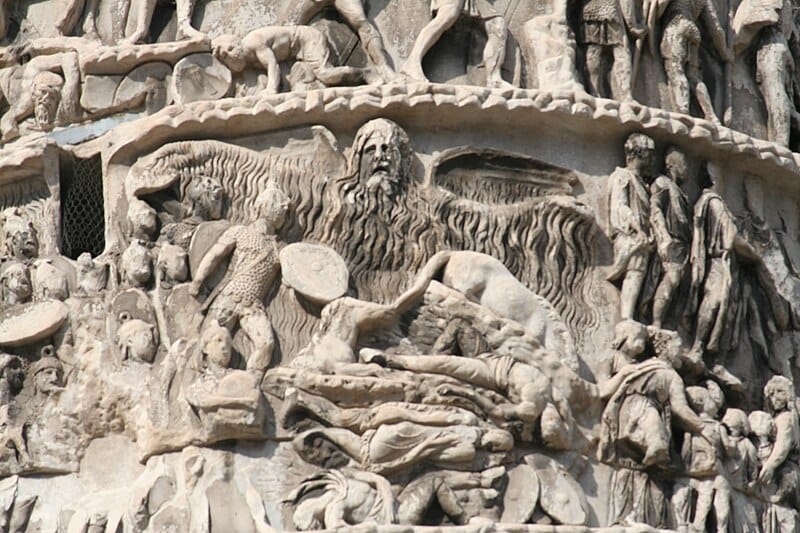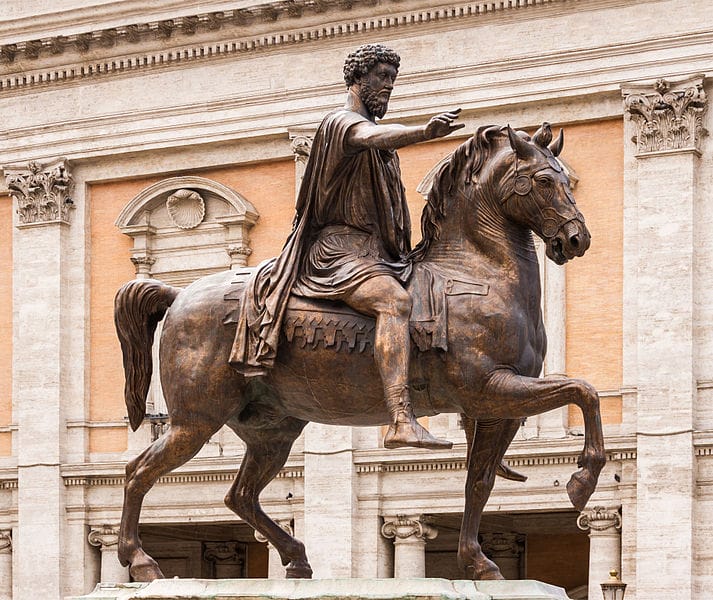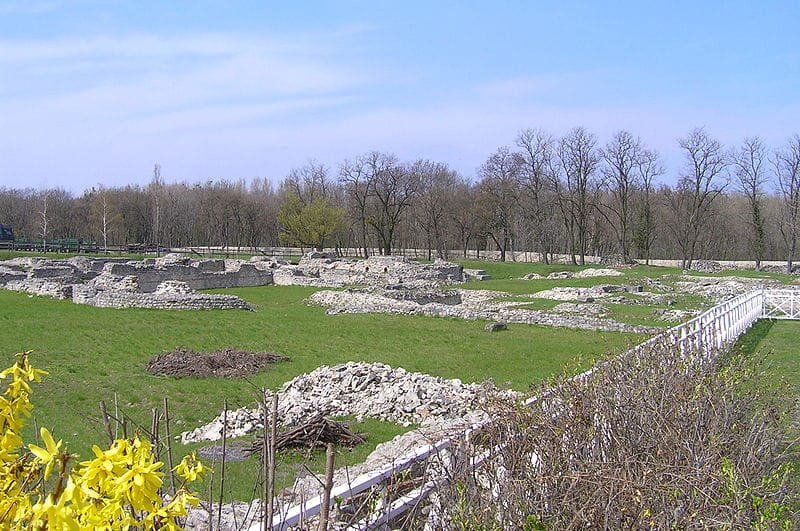The Marcomannic Wars were a series of conflicts fought between the Roman Empire and a coalition of Germanic and Sarmatian tribes, including the eponymous Marcomanni, during the late 2nd century AD. Although named after the Marcomanni, these wars saw the involvement of various other tribes, emphasizing the complexity and scale of the conflicts. They took place during the reign of Emperor Marcus Aurelius and are considered to be among the most significant military operations of the Roman Empire, testing its resilience and military strategy.

Source: Barosaurus Lentus, CC BY 3.0 https://creativecommons.org/licenses/by/3.0, via Wikimedia Commons
These confrontations were not only notable for their military engagements but also for their cultural and political ramifications. The Marcomannic Wars had considerable consequences on the borders of the Roman Empire, leading to changes in both the Roman military organization and frontier policy. As the empire struggled to manage prolonged warfare and external threats, these wars also highlighted the role of leadership and the importance of tactical innovations, both of which were paramount in preserving the stability and territorial integrity of Rome.
Key Takeaways
- The Marcomannic Wars were a significant challenge to the Roman Empire, involving multiple Germanic and Sarmatian tribes.
- These wars had profound effects on Roman military and political strategies, as well as on border policies.
- Leadership and military tactics during the conflicts were crucial in maintaining the empire’s stability.
Historical Context
Rise of the Germanic Tribes
The Germanic tribes, such as the Marcomanni, Quadi, and others, experienced a significant rise in power and influence in the years leading up to the Marcomannic Wars. These tribes were situated primarily north of the Danube River – a crucial frontier of the Roman Empire. The Marcomanni had established themselves in regions that are part of modern-day Bohemia and Bavaria in the Czech Republic and Germany, while the Quadi were settled to the east in areas corresponding to present-day Moravia (also Czech Republic) and Slovakia.
Their increasing power and movements posed a continual threat to Roman territory, intensifying tensions along the Danube and the northeastern borders of the empire. Roman provinces such as Noricum and Pannonia lay directly in the path of these tribes’ potential expansion, states that had cultivated rich Roman cultural and economic presence.
The Sarmatians, another prominent group, were also involved, occupying the vast Hungarian Plain and stretching into territories in Sarmatia, which covered expansive areas of Eastern Europe. Roman engagements with these tribes were not merely military but were also deeply enmeshed with the strategic imperative to maintain and control the empire’s northeastern European border.
These conflicts were not isolated incidents; rather, they were symptomatic of wider pressures such as population movements within Germania and beyond. The diverse Germanic tribes, brought together by common challenges and opportunities, thus found themselves increasingly at odds with the Roman world.
Key Figures and Leadership
Emperor Marcus Aurelius

Marcus Aurelius, the Roman Emperor from 161 AD to his death in 180 AD, was a key figure during the Marcomannic Wars. A philosopher-king, he authored Meditations during his campaigns. His leadership was marked by his efforts to secure the northern frontier against the invading Germanic tribes.
Co-Emperor Lucius Verus
Lucius Verus, co-emperor with Marcus Aurelius until his death in 169 AD, was initially responsible for the war efforts against the Germanic tribes. His early campaigns against the barbarians ended quickly, and he was criticized for his indolence.
Germanic Leaders
The Marcomannic Wars featured several notable Germanic leaders. Among them was Ballomar, the king of the Marcomanni, who led the coalition of Germanic tribes against Rome. Ariogaesus, leader of the Sarmatian Iazyges, was eventually captured by Roman forces and sent into exile.
Key Belligerents:
- Marcomanni
- Sarmatian Iazyges
Roman Commanders and Legates
Numerous Roman commanders played vital roles in the Marcomannic Wars. Gaius Vettius Sabinianus, a legate, is noted for his contributions, and Lucius Gallus Julianus commanded Roman legions to several victories.
Chronology of Conflicts
Initial Battles and Roman Setbacks
In the beginning, the Roman Empire faced multiple incursions along the Danube border. Around AD 166, the Marcomanni, Quadi, and other Germanic tribes launched an attack, spearheaded by an invasion into Roman territory, targeting the Italian front. The first wave of attacks saw the adversaries push the Romans back to Aquileia, a strategic Roman stronghold, causing alarm throughout the Italian Peninsula.
Chronology of Initial Battles:
- AD 166: Advancement of Germanic tribes into Roman lands.
- AD 167: The Italian interior, including Opitergium, endures invasions.
During this phase, vital Roman fortifications such as Carnuntum were stressed, and the Roman military machine suffered setbacks in defending its territorial integrity.

Critical Engagements and Turning Points
As conflicts progressed, the Romans reorganized under Marcus Aurelius. By AD 170, decisive Roman victories began to turn the tides of war. Key confrontations occurred around the Danube region, where the Romans combined strength and strategic expertise to recapture lost ground.
Major Turning Points:
- Between AD 170-180: Critical military operations lead to the recuperation of occupied territories.
- AD 172: Roman forces successfully defended Aquileia and initiated a counter-offensive.
- AD 174: The Roman army holds and then recaptures Carnuntum.
The proper coordination of Roman legions and leadership led to a series of encounters where the invaders were pushed back, ultimately culminating in the stabilization of the Danube frontier. Although Marcus Aurelius did not live to see lasting peace, his strategic interventions laid the groundwork for the war’s conclusion, with the last significant campaigns occurring before his death in AD 180.
Cultural and Political Impact
Legacy of Rome and the Empire
The extended conflict between Rome and the Marcomannic tribes had significant ramifications for the Roman Empire. It tested the military strength and administrative capabilities of the empire, ultimately reinforcing the presence and influence of the military within Roman society and governance. As the wars against the Marcomannic coalition unfolded, it became apparent that Rome’s dominance could be challenged, demanding not only military but also diplomatic responses.
Military Reforms: Emperor Marcus Aurelius initiated reforms to improve the military’s readiness and adaptability in response to the changing warfare dynamics.
- Increased Military Spending: Financial resources were allocated to enhance the Roman army’s capabilities.
- Strategic Fortifications: Rome reinforced its borders, especially the limes, to safeguard against further incursions.
Column of Marcus Aurelius
The Column of Marcus Aurelius stands as a monumental testament to the Marcomannic Wars. Commissioned by the Roman Senate to commemorate Emperor Marcus Aurelius’ victories, the towering column is both an artistic and historical chronicle.
Cultural Significance: Engraved with a spiraling frieze, the column depicts various aspects of the campaigns, providing insights into the military gears, tactics, and significant events of the war.
Historical Record:
- Detailed Imagery: Scenes etched into the marble narrate the story of the wars, offering a visual account of the conflict’s key moments.
- Propaganda Tool: The column served to glorify the emperor’s achievements, illustrating his role as a successful military leader and protector of Rome.
Influence on Succession and Governance
The consequences of the Marcomannic Wars also extended into the political sphere, shaping imperial succession and internal governance. Emperor Marcus Aurelius’ decisions during and after the conflict highlighted this influence.
Succession Choices:
- Commodus: Marcus Aurelius’ son and successor, Commodus, was brought to the forefront, suggesting that the emperor’s experiences in the wars influenced his decision to anoint his son, possibly recognizing the need for a youthful and energetic successor in a time of military strain.
Internal Stability Measures:
- Power Balancing: The appointment of key military leaders to prominent political positions looked to balance power dynamics.
- Foreign Relations: Diplomatic relations with Germanic tribes evolved to incorporate more strategic alliances and understandings.
Military Strategies and Tactics
The Marcomannic Wars witnessed the employment of a well-organized Roman military structure against the versatile and relentless combat style of the Germanic tribes.
Roman Military Organization
The Roman Armed Forces were a complex and highly structured entity, operating with meticulous organization. Legions formed the backbone of the Roman military might, each composed of several thousand infantry troops coupled with supportive cavalry. These legions were further subdivided into vexillationes, smaller detachable units deployed for specialized missions. Command of the legions fell to experienced Field Marshals, who executed strategic maneuvers aiming to suppress the insurgent Germanic tribes and protect the vulnerable Roman provinces, like Dacia, which were key to the empire’s security and resource flow.
- Deployment: Troops were strategically stationed along borders and potential flashpoints to deter incursions.
- Fortifications: Heavily fortified military camps served as both defensive bastions and offensive launchpads.
- Logistics: Meticulous attention to supply lines ensured legions remained combat-ready.
Germanic Warfare Methods
The Germanic tribes were known for their ferocious and guerrilla-style warfare tactics. Unlike the disciplined Roman formations, the Germanic People leveraged their familiarity with the local terrain to launch sudden attacks that aimed to destabilize the Roman frontier defenses. These combat methods often resulted in significant casualties on both sides due to the unpredictable nature of the engagements and the Germanic resolve to resist Roman expansion. These tribal groups lacked a centralized military command, operating instead as a coalition of independent units that struck swiftly and retreated, making them a persistent threat to stability in the region.
- Raiding: Small-scale, high-mobility assaults on Roman outposts and supply trains were common.
- Ambushes: Utilizing the region’s forests and rough terrain to their advantage, Germanic warriors frequently ambushed Roman forces.
- Polycentric resistance: Multiple chieftains and tribal groups acted independently, creating a web of resistance across various fronts.
Aftermath and Historical Significance
These conflicts against the Marcomanni and other Germanic tribes disrupted the image of an invulnerable Rome, revealing its susceptibility to barbarian incursions.
Following the wars, Commodus, the son of Marcus Aurelius, assumed the title of Augustus. His ascent marked a shift in priorities from his father’s military campaigns to a pursuit of peace, often viewed as detrimental to Rome’s strategic interests. The Goths, for instance, took advantage of the Empire’s diverted focus, pressing into Roman territories.
The internal stability of the Roman Empire began to waver; ramifications were felt in regions such as Gaul and Britain. In Gaul, the wars provoked social and economic disturbances. Britain, while remote, was not immune to the widespread consequences with incursions and revolts stirring along its frontiers.
The enduring legacy of the wars also influenced the Roman administrative and military structures. A need for more robust defenses against external threats led to fortification expansions along the limes. The Empire experienced an increased reliance on foreign mercenaries, which later had implications for its military consistency and loyalty.
Historical sources provide various accounts of the aftermath of the Marcomannic Wars. They depict the gradual disintegration of the Pax Romana – a period of relative peace and stability that the Empire had enjoyed under earlier emperors. This era’s end accelerated shifts in Roman policy and strategy that would foreshadow challenges to come.
People Also Ask:
What caused the conflicts between the Romans and the Germanic tribes that led to the Marcomannic Wars?
The conflicts known as the Marcomannic wars arose from Germanic tribes, including the Marcomanni, pressured by migrations and resource scarcity, pushing into Roman territories. Roman defense mechanisms and geopolitical strategies also played a role in provoking hostilities.
Which territories were involved in the Marcomannic Wars according to historical maps?
Historical maps indicate that the Marcomannic Wars took place along the Danubian frontier of the Roman Empire. This included regions of Central Europe, encompassing parts of modern-day Hungary, Slovakia, Czech Republic, and other areas bordering the Danube River.
What was the significance of the Marcomanni tribe in the context of the Marcomannic Wars?
The Marcomanni were a prominent Germanic people whose movements and opposition to Roman expansion were a catalyst for the conflict. Their role is underscored by the naming of the Marcomannic Wars, signifying their central position in the hostilities.
What were the outcomes and consequences of the Marcomannic Wars?
The wars ended with a Roman victory, but the prolonged conflict strained Rome’s resources and military. It resulted in short-term peace treaties and a shift in the Roman defensive strategy, including fortifications along the northern frontier. These events also foreshadowed future troubles with Germanic tribes for the empire.
How did Emperor Marcus Aurelius handle the military campaigns during the Marcomannic Wars?
Emperor Marcus Aurelius is credited with diligent and capable leadership during the Marcomannic Wars. He personally led campaigns, secured fortifications, and dealt with internal and external pressures that impacted the war’s progress and Roman stability.
How has the Marcomannic Wars influenced the historical perception of Roman-Germanic relations?
The wars have had a substantial influence on historical perspectives of Roman-Germanic interactions by highlighting the volatility of the frontier regions and the complexity of the relationship. The conflicts illustrate the blend of military confrontation and cultural exchanges that characterized Roman-Germanic encounters.
Hello, my name is Vladimir, and I am a part of the Roman-empire writing team.
I am a historian, and history is an integral part of my life.
To be honest, while I was in school, I didn’t like history so how did I end up studying it? Well, for that, I have to thank history-based strategy PC games. Thank you so much, Europa Universalis IV, and thank you, Medieval Total War.
Since games made me fall in love with history, I completed bachelor studies at Filozofski Fakultet Niš, a part of the University of Niš. My bachelor’s thesis was about Julis Caesar. Soon, I completed my master’s studies at the same university.
For years now, I have been working as a teacher in a local elementary school, but my passion for writing isn’t fulfilled, so I decided to pursue that ambition online. There were a few gigs, but most of them were not history-related.
Then I stumbled upon roman-empire.com, and now I am a part of something bigger. No, I am not a part of the ancient Roman Empire but of a creative writing team where I have the freedom to write about whatever I want. Yes, even about Star Wars. Stay tuned for that.
Anyway, I am better at writing about Rome than writing about me. But if you would like to contact me for any reason, you can do it at [email protected]. Except for negative reviews, of course. 😀
Kind regards,
Vladimir
